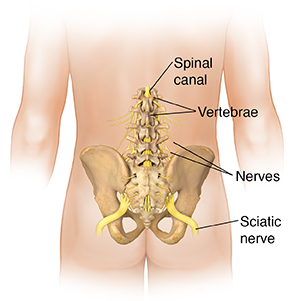Sciatica
What is sciatica?
Sciatica, also called lumbar radiculopathy, is a pain that originates along your sciatic nerve. It's a symptom of an underlying condition, not a diagnosis. The sciatic nerve extends from the back of your pelvis down the back of your thigh. Your sciatic nerve is the main nerve in your leg. It's also the largest nerve in your entire body.

What causes sciatica?
Usually, sciatica is caused by a herniated (or bulging) disk in your spine that presses on your sciatic nerve.
Other reasons for pressure on your sciatic nerve may include:
-
Obesity
-
Poor posture
-
Tumor
-
Abscess
-
Blood clot
-
Awkward sitting position
-
Any nerve disorders
Health conditions, such as diabetes or Lyme disease, can cause symptoms of sciatica. Sometimes, the cause for your sciatica can't be identified.
What are the symptoms of sciatica?
These are the most common symptoms of sciatica:
-
Lower back pain that radiates or spreads down your buttock and the back of one thigh
-
Pain that extends from your buttock down to your foot
-
Numbness (in severe cases)
-
Weakness (in severe cases)
The symptoms of sciatica may look like other conditions or health problems. Always see your healthcare provider for a diagnosis.
How is sciatica diagnosed?
Along with a complete medical history and physical exam, tests for sciatica may include:
-
X-ray. Electromagnetic energy beams make images of internal tissues, bones, and organs onto film.
-
MRI. Large magnets, radio waves, and a computer make detailed images of organs and structures in your body.
-
Electromyography and nerve conduction study (EMG and NCS). A procedure done together to record and analyze electrical impulses in your muscles. During the EMG, thin needles are placed in your muscle to record electrical activity. The NCS is often done along with the EMG to determine if a nerve is working normally. Electrodes are then placed in various locations on your skin along the nerve pathway. When stimulating the nerve at various places, your healthcare provider can then find the specific site of your injury.
-
Myelogram. This is an invasive procedure that uses a special dye (contrast material) to be injected through a needle into the spinal canal. The dye helps any deformities to show up on X-rays. This procedure is normally only done when other tests don't find the cause of the symptoms.
How is sciatica treated?
Sciatica usually heals on its own with some rest, appropriate movement, and time.
Physical activity is important. Don’t stay in bed. Lack of movement will cause problems in other parts of your body.
Find a comfortable position, but stay as active as you can. As strange as it may seem, appropriate motion helps to reduce inflammation and pain. Talk to you healthcare provider about when to start stretching exercises so you can resume regular physical activities without pain. Your provider may suggest short walks or physical therapy.
To help relieve the pain, treatment may include:
-
Nonsteroidal anti-inflammatory drugs, (NSAIDs) such as ibuprofen
-
Heat or cold applied to the sore muscles
-
Specific stretching exercises or physical activities (motion reduces inflammation)
-
Osteopathic manipulation
-
Surgery (to fix your herniated disk, if the condition persists)
What are possible complications of sciatica?
Because sciatica is caused by pressure on a nerve in your spine, complications may develop if the pressure is not relieved. Possible complications of unrelieved nerve compression include:
-
Increased pain
-
A slipped or herniated disc
-
Loss of feeling or weakness in your affected leg
-
Loss of bowel or bladder function
-
Permanent nerve damage
When should I call my healthcare provider?
Call your healthcare provider if:
-
You develop back pain when you have a history of cancer.
-
You have a high fever.
-
Your pain gets worse.
-
You lose feeling in your affected leg or notice weakness in your leg.
-
You develop problems with your bowels or bladder.
-
Your pain returns after successful treatment of your sciatica.
Key points about sciatica
-
Sciatica most commonly occurs in people between the ages of 30 and 50 years.
-
It's pain that starts along your sciatic nerve and spreads down your buttock and the back of one thigh.
-
It's usually caused by a herniated (or bulging) disk in your spine that presses on your sciatic nerve.
-
Sciatica usually heals on its own with some rest, appropriate exercise, and time.
Next steps
Tips to help you get the most from a visit to your healthcare provider:
-
Know the reason for your visit and what you want to happen.
-
Before your visit, write down questions you want answered.
-
Bring someone with you to help you ask questions and remember what your provider tells you.
-
At the visit, write down the name of a new diagnosis, and any new medicines, treatments, or tests. Also write down any new instructions your provider gives you.
-
Know why a new medicine or treatment is prescribed, and how it will help you. Also know what the side effects are.
-
Ask if your condition can be treated in other ways.
-
Know why a test or procedure is recommended and what the results could mean.
-
Know what to expect if you do not take the medicine or have the test or procedure.
-
If you have a follow-up appointment, write down the date, time, and purpose for that visit.
-
Know how you can contact your healthcare provider if you have questions.